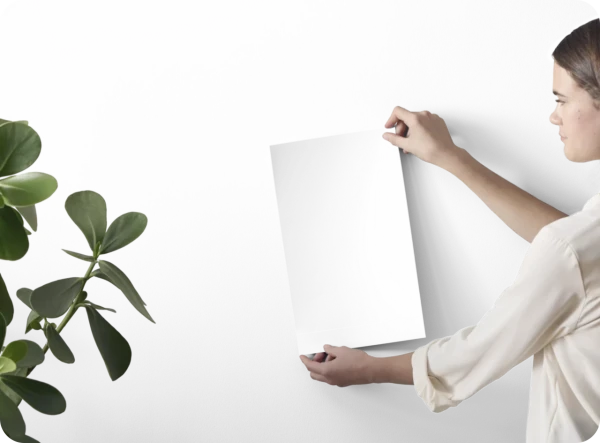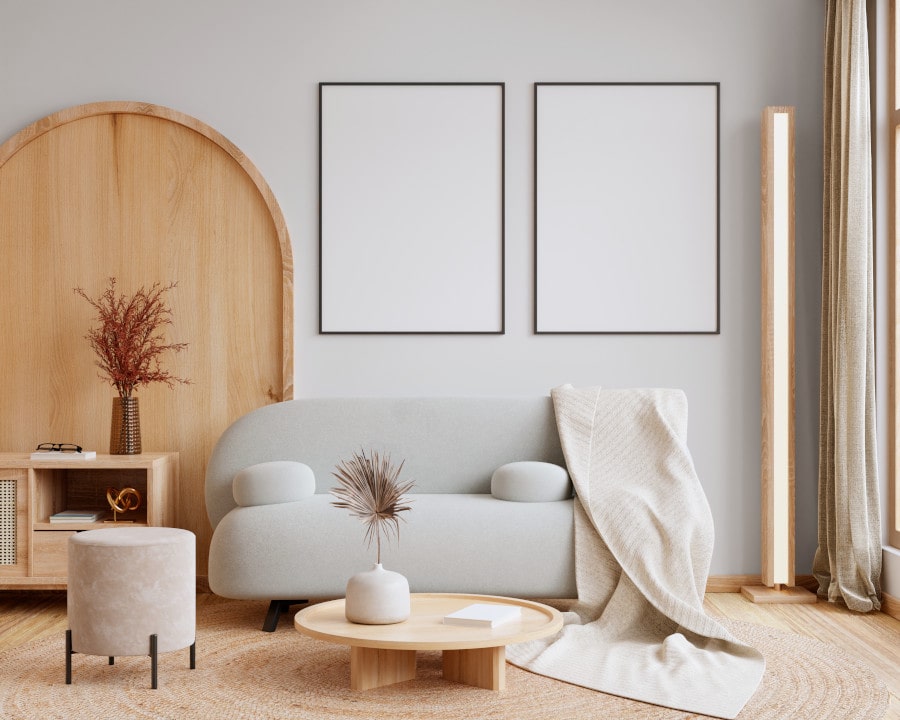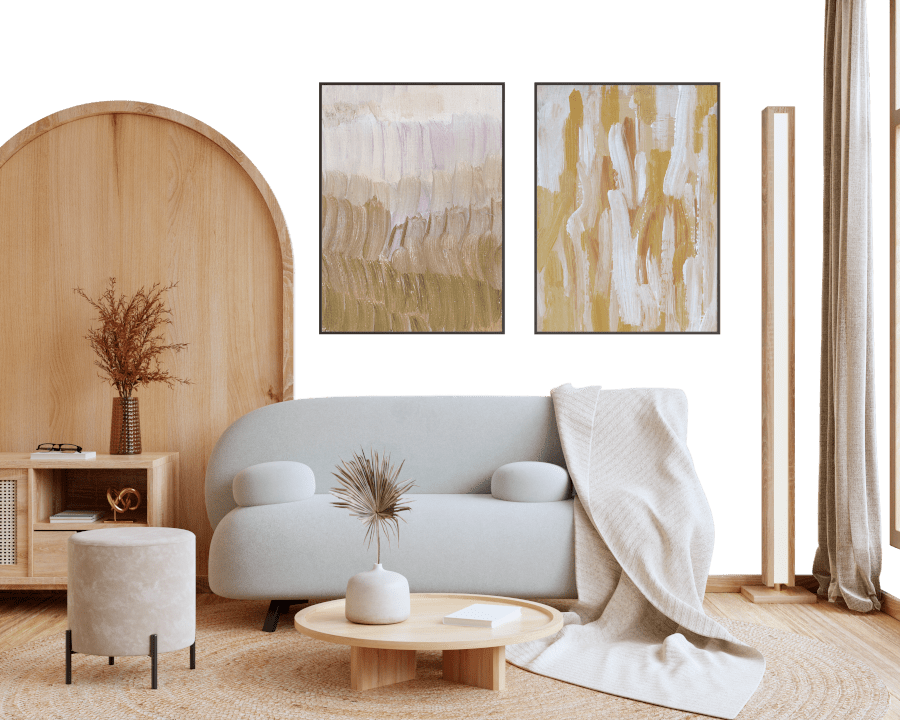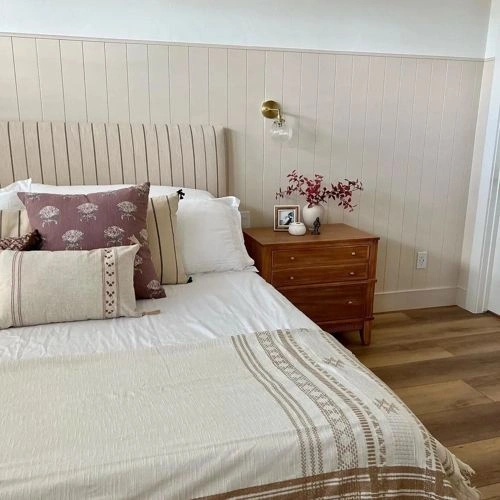Benjamin Moore Painted Sands 1142
| Official page: | Painted Sands 1142 |
| Code: | 1142 |
| Name: | Painted Sands |
| Brand: | Benjamin Moore |
What color is Benjamin Moore Painted Sands?
The rich hue of Benjamin Moore 1142 Painted Sands brings warmth and sophistication to any space. This versatile color pairs beautifully with soft neutrals like white and beige for a classic look, or can be complemented by bolder shades such as navy blue or olive green for a more dramatic effect. The subtle undertones of 1142 Painted Sands add depth and dimension to a room, creating a sense of timeless elegance. Whether used as a main color or as an accent, this paint color can enhance the overall ambiance of a room with its understated beauty.
Try before you buy


100% accurate
reusable paint samples

Peel, stick,
and repeat

Twice painted
with real paint

Next day
delivery
What are Benjamin Moore Painted Sands undertones?
The undertone of Painted Sands can be accurately described as a Red hue, as is apparent from the color space provided. By isolating the pure hue and eliminating any tints, tones, and shades, we were able to precisely determine its undertone. This approach has proven to be more accurate than traditional methods of defining undertones on a white background, which are now considered outdated.
HEX value
HEX value:
#EBD7BF
RGB code:
235, 215, 191
Is Benjamin Moore Painted Sands 1142 cool or warm?

With a hue of 33° thisBeigerefers warm paint shade according to HSL (Hue, Saturation, Lightness) on the color wheel.
1142 Painted Sands HSL code: 33, 52%, 84%
Hue - degree on a color wheel from 0 to 360. 0 is red, 120 is green, and 240 is blue.
Saturation is expressed as a percentage. At 0%, it appears as a shade of grey, and at 100%, it is in full color..
Lightness is also a percentage value. 0% is black, and 100% is white.
- Warm colors are ideal for kitchens, living rooms or bathrooms
- Warmer hues make larger spaces feel more inviting
- Warm beige shades create a cozy and inviting atmosphere, making any room feel comfortable and welcoming, perfect for living rooms, bedrooms, and hallways.
- To prevent a space from feeling too monotonous, consider pairing warm light shades with richer tones like deep greens or browns, or adding textures through fabrics and furnishings. Avoid using them in rooms with limited natural light, as they may appear too dull or yellowish
Act like a pro: Mixing warm and cool shades is a must have to get harmonius interior. Add accents that contrast with the primary color to create visual balance. If your walls are a warm color, don’t forget to add accent in cold colors (furniture, art, décor). A good practice is too use a complementary color scheme.
How light temperature affects Painted Sands
Natural Lighting. During the day, natural light shifts from about 2000 K at sunrise/sunset to 5500–6500 K at noon.
In addition, natural‑light temperature depends on its direction:
| Direction of sunlight | Visible temp. | Hue | Duration |
|---|---|---|---|
| North | Cool | Bluish | All day |
| East | Warm | Yellow | Before noon |
| West | Warm | Orange‑red | After noon |
| South | Warm | Orange‑yellow | All day |
Artificial Lighting. When choosing bulbs, pay attention to their color‑temperature (Kelvins).
Use the slider to see how this Beige shade looks under different lighting:


4000K
Coordinating colors.
Colors that go with Benjamin Moore Painted Sands:
Monochromatic color scheme

This scheme consists of various shades, tints, and tones of a single color. While it offers a perfect combination of hues, without accent décor it may become monotonous.
Lighter shades
1142
Painted Sands
Darker shades
Complementary color scheme

This color scheme is a combination of two shades that are opposite each other on the color wheel. The high contrast between these colors creates a vibrant and dynamic visual effect. For the color Painted Sands with a orange hue, complementary colors are those with a blue hue close to 213, such as Benjamin Moore Amsterdam and French Toile.
LRV of Painted Sands
Painted Sands has an LRV of 69.45% and refers to Light colors that reflect most of the incident light. Why LRV is important?

Light Reflectance Value measures the amount of visible and usable light that reflects from a painted surface.
Simply put, the higher the LRV of a paint color, the brighter the room you will get.
The scale goes from 0% (absolute black, absorbing all light) to 100% (pure white, reflecting all light).
Act like a pro: When choosing paint with an LRV of 69.45%, pay attention to your bulbs' brightness. Light brightness is measured in lumens. The lower the paint's LRV, the higher lumen level you need. Every square foot of room needs at least 40 lumens. That means for a 200 ft2 living room you’ll need about 8000 lumens of light – e.g., eight 1000 lm bulbs.
Color codes
We have collected almost every possible color code you could ever need. To copy the code, just click the icon to the right of it.
| Format | Code | |
|---|---|---|
| HEX | #EBD7BF | |
| RGB Decimal | 235, 215, 191 | |
| RGB Percent | 92.16%, 84.31%, 74.90% | |
| HSV | Hue: 33° Saturation: 18.72% Value: 92.16% | |
| HSL | hsl(33, 52, 84) | |
| CMYK | Cyan: 0.0 Magenta: 8.51 Yellow: 18.72 Key: 7.84 | |
| YIQ | Y: 218.244 I: 19.63 Q: -3.238 | |
| XYZ | X: 67.964 Y: 70.026 Z: 59.212 | |
| CIE Lab | L:87.01 a:3.106 b:14.355 | |
| CIE Luv | L:87.01 u:13.492 v:20.314 | |
| Decimal | 15456191 | |
| Hunter Lab | 83.682, -1.469, 16.624 |
Color equivalents
PPU4-10
Porcelain Skin
Behr
1087
Creamy Satin
Benjamin Moore
N280-2
Writer'S Parchment
Behr
SW 0035
Warm Beige
Sherwin Williams
S260-1A
Cake Crumbs
Behr
HDC-MD-17
Minimum Beige
Behr
S280-2
Beach Grass
Behr
HC-57
Sheraton Beige
Benjamin Moore

S270-1
Frosted Toffee
Behr
SW 7572
Lotus Pod
Sherwin Williams

1072
Sand Dunes
Benjamin Moore
SW 7560
Impressive Ivory
Sherwin Williams

2162-60
Mystic Beige
Benjamin Moore



